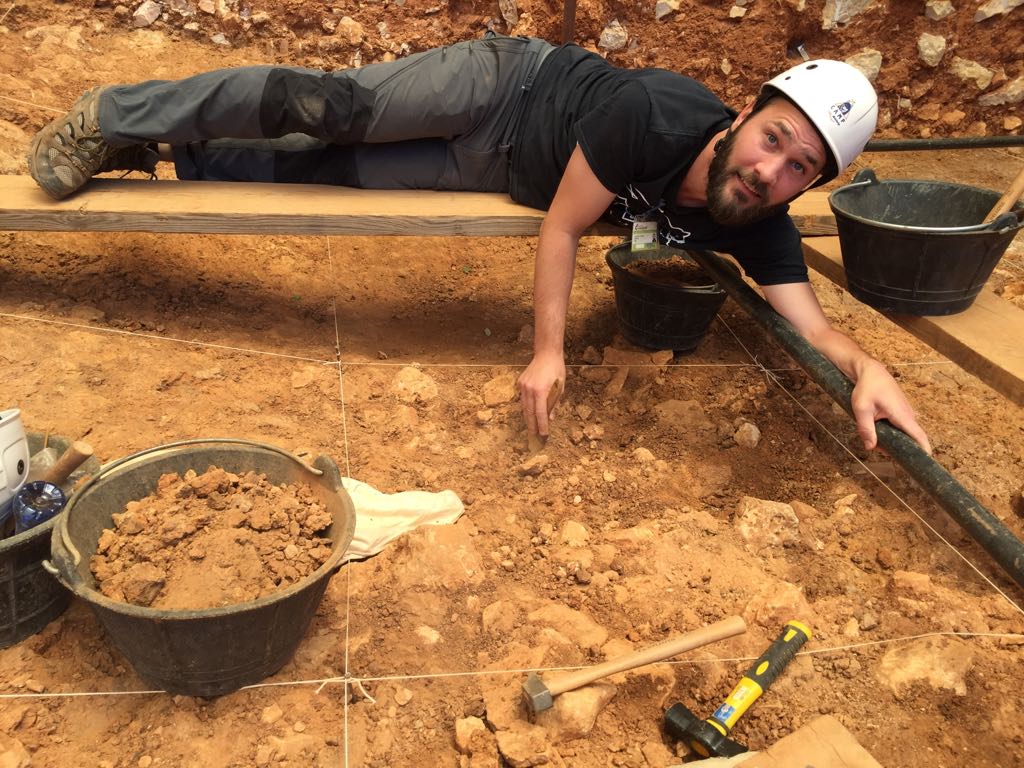April 16, 2024

To celebrate our 2024-2025 Fellowship recipients, we reached out to our winners to learn about their projects and their experiences in archaeology. We’re excited for you to meet Dr. John Willman, this year’s Archaeology of Portugal Fellowship recipient.
The Archaeology of Portugal Fellowship Recipient: Dr. John Willman; Universidade de Coimbra
This year’s AIA Archaeology of Portugal Fellowship winner, Dr. John Charles Willman (University of Coimbra), will use high-resolution medical imaging data to virtually curate human remains and learn about human mobility and biological diversity among prehistoric populations located in present-day Portugal. The innovative methodology undertaken by Willman using high-resolution microcomputed tomography (micro CT) scans will create virtual models that can be preserved in perpetuity and will provide unparalleled sample sizes compared to destructive methods like ancient DNA and isotopic studies. This should provide a more complex, nuanced understanding regarding the movement and intermingling of past populations within the same burial location, at the site level, and within a region.
Willman’s fellowship project will involve travel to several repositories throughout Portugal, and micro CT scanning at three different institutions in Lisbon, Porto, and Bordeaux. It will wrap up with virtual analyses of the images. Willman plans to make all virtual models and data derived from this research available in an open-access format upon publication of his results. He hopes this project will be a launchpad for future research, including 1) minimally destructive enamel peptide analysis to determine sex and explore gendered mobility, 2) analyses of dental microwear and understand sex-, age-, and site-based variation in diet, and 3) strontium isotope analyses to cross-validate and refine the conclusions made in the study he is undertaking now with funds from the AIA. We can’t wait to learn more about future discoveries made by this promising scholar!
How did you get your start in archaeology?
I was always fascinated with prehistory but it was during my undergraduate education at The University of Iowa that I became serious about it. My first experience with archaeological excavation was in the Netherlands, but soon after I joined excavations at the Neolithic to Early Bronze Age rock-cut tomb of Bolores in Torres Vedras (Portugal) under the direction of Prof. Katina Lillios. It was my first experience excavating a mortuary context and cemented my interest in bioarchaeological analyses of human remains and Iberian prehistory. In graduate school, I joined excavations of the Middle Paleolithic site of Gruta da Oliveira in Torres Novas (Portugal) under the direction of Prof. João Zilhão. While I have worked at a variety of other sites, these two experiences were instrumental in shaping my interest in the prehistory Portugal and the Iberian Peninsula.
Where in the world has archaeology brought you (fieldwork, research, conference travel, etc.)?
As a paleoanthropologist and bioarchaeologist, I specialize in the analysis Pleistocene and Holocene human remains. My research has given me the incredible opportunity to study and collaborate on analyses of human remains at more than 50 institutions and museums around the world. So far, I have worked in Austria, Belgium, Canada, China, Croatia, Czech Republic, France, Germany, Israel, Italy, Netherlands, Poland, Portugal, Romania, Spain, Switzerland, United Kingdom, and the United States. I’ve worked on everything from contemporary anatomy collections to human fossils from Middle Pleistocene contexts. My archaeological fieldwork has primarily been in the United States, Spain, and Portugal. I currently excavate the Middle Pleistocene site of Gruta do Aderno in Torres Novas, Portugal.
What is one of the most memorable things that has happened to you in the field?
While excavating at the Gruta da Oliveira, I found a partial Neandertal tooth while sieving and spotted another Neandertal tooth while we were breaking breccia inside the cave. I work extensively with teeth—as suggested by the theme of my AIA Archaeology of Portugal Fellowship research—so the discovery of rare Middle Paleolithic human teeth was incredibly exciting for me. More recently, I spotted a beautiful limestone biface (“handaxe”) at our excavations at Aderno.
How has the AIA contributed to your success/professional goals?
The AIA has provided an incredible opportunity for me to travel to museums and institutions around Portugal to study bioarchaeological materials from numerous archaeological contexts. The funding of microCT scanning will also contribute to open access datasets ensuring that other researchers have access to the virtual models created through this project. One of the joys of this kind of research is to revisit institutions I first went to at the beginning of my adventure in Portuguese archaeology and travel to museums that I have never been to before. Portugal is my home now, so any opportunity to see more of the country and continue studying its prehistory is very rewarding.
John’s project, made possible by donors like you, will contribute significantly to understanding past peoples’ biocultural diversity and behaviors. This technology also offers an alternative, non-destructive solution for conducting these analyses. Your contribution can help fund groundbreaking research like John’s and help send archaeologists into the field.
Learn more about what Fellowship opportunities are available through the AIA or reach out to our Programs and Professional Services Coordinator, Kati Albert at kalbert@archaeological.org.